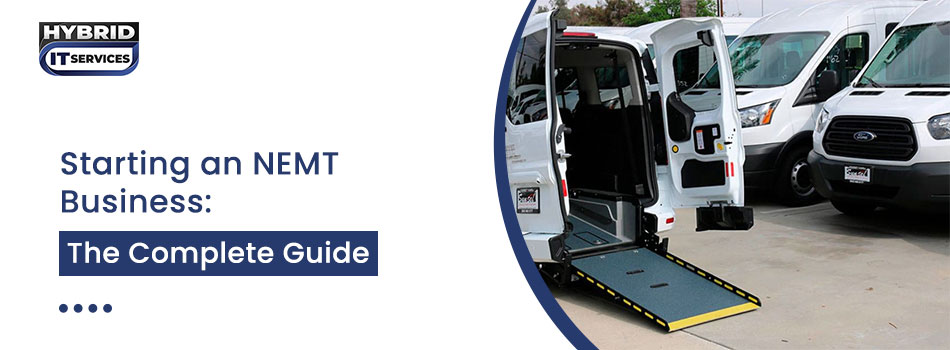In recent years, the demand for Non-Emergency Medical Transportation (NEMT) services has grown significantly, driven by an aging population and increasing healthcare needs. Starting a NEMT business can be a rewarding venture both financially and personally, as it involves providing vital transportation services to those who need assistance getting to medical appointments.
What is a Non-Emergency Medical Transportation Business?
A Non-Emergency Medical Transportation (NEMT) business provides transport services for individuals who do not require emergency medical care but need assistance getting to medical appointments, such as elderly or disabled patients. These services are crucial for ensuring that patients can access necessary healthcare services without relying on emergency services unnecessarily.
Steps to Start a Medical Transportation Business
Starting any business begins with thorough research and planning. For a medical transportation business (NEMT), this involves:
Research and Planning
Market Research: Identify the demand for NEMT services in your target area. Consider demographics such as aging populations or areas lacking adequate transportation services for medical appointments.
Competitive Analysis: Assess existing NEMT providers in your region. Understand their service offerings, pricing strategies, and customer base to identify gaps or opportunities for differentiation.
Business Plan: Develop a comprehensive business plan outlining your company's mission, services offered (e.g., wheelchair-accessible vans, stretcher transportation), target market segments (e.g., hospitals, nursing homes, individual patients), marketing strategies, operational plan, and financial projections. A well-crafted business plan not only guides your initial steps but also serves as a roadmap for future growth and financing.
Legal Considerations
Navigating legal requirements is crucial to ensure compliance and legitimacy for your medical transportation business:
Business Structure: Decide on a suitable legal structure for your business, such as sole proprietorship, partnership, LLC (Limited Liability Company), or corporation. Each structure has implications for taxes, liability, and operational flexibility.
Licenses and Permits: Obtain necessary licenses and permits to operate an NEMT business in your jurisdiction. Requirements vary by state and may include business licenses, transportation permits, and compliance with local health and safety regulations.
Insurance: Secure adequate insurance coverage tailored to NEMT services. This typically includes liability insurance, commercial auto insurance (covering vehicles and passengers), and potentially, medical liability insurance to protect against claims related to patient transport.
Vehicle Acquisition and Maintenance
Choosing and maintaining suitable vehicles is critical to delivering safe and reliable transportation services:
Invest in vehicles equipped for medical transportation, such as wheelchair-accessible vans or vehicles with stretcher capabilities. Ensure vehicles comply with ADA (Americans with Disabilities Act) accessibility standards and local regulations.
Implement regular maintenance schedules to keep vehicles in optimal condition. Conduct safety inspections, including wheelchair lifts or ramps, emergency equipment, and cleanliness standards. Compliance with safety regulations not only ensures passenger safety but also extends the lifespan of your fleet.
Staffing and Training
Recruiting and training competent staff is essential for delivering high-quality NEMT services:
Hire Qualified Drivers: Hire drivers with clean driving records, appropriate licensing (e.g., commercial driver's license with passenger endorsement), and a commitment to customer service. Conduct background checks and drug screenings as required by local regulations.
Comprehensive Training: Provide comprehensive training on safe driving practices, patient handling techniques, emergency procedures, and customer care. Training should emphasize sensitivity to the needs of elderly or disabled passengers, ensuring compassionate and respectful service delivery.
Marketing and Networking
Effective marketing strategies help promote your NEMT business and establish relationships with key stakeholders:
Target Audience: Identify target markets, such as hospitals, nursing homes, rehabilitation centers, and individual patients requiring regular medical appointments.
Branding and Messaging: Develop a strong brand identity that communicates reliability, professionalism, and compassion. Create marketing materials (e.g., website, brochures, business cards) that highlight your services, unique selling propositions, and testimonials from satisfied clients.
Networking: Build relationships with healthcare providers, social service agencies, and community organizations. Participate in industry events, health fairs, and networking opportunities to generate referrals and partnerships that can sustain business growth.
Regulatory Compliance and Risk Management
Adhere to regulatory requirements and mitigate operational risks to protect your business and clients:
Stay informed about local, state, and federal regulations governing NEMT services, including privacy laws (e.g., HIPAA compliance for patient information), vehicle safety standards, and operational licensing requirements.
Develop protocols for handling emergencies, patient transfers, and adverse events during transport. Train staff on crisis management procedures and maintain adequate insurance coverage to protect against liability claims and unforeseen incidents.
Growth and Sustainability
Plan for long-term growth and sustainability through strategic initiatives and continuous improvement:
Expansion Opportunities: Explore opportunities to expand services, such as adding new vehicle types or extending service areas to reach more clients.
Community Engagement: Engage with the community through outreach programs, educational workshops, and partnerships with healthcare providers to enhance your brand reputation and client base.
Financial Management: Monitor financial performance closely, tracking revenue streams, operating expenses, and profitability margins. Seek opportunities for cost savings and revenue growth while maintaining high service standards and client satisfaction.
By following these detailed steps, aspiring entrepreneurs can navigate the complexities of starting a medical transportation business successfully. Each stage requires careful planning, adherence to legal requirements, investment in quality vehicles and staff, effective marketing strategies, and commitment to operational excellence. With a focus on delivering compassionate and reliable NEMT services, businesses can build a strong reputation and contribute positively to their communities' healthcare access.
Choose NEMT Software for Your Business Growth
NEMT software plays a crucial role in the efficient management of an NEMT business. This software automates dispatching, route optimization, and scheduling, allowing you to manage bookings in real-time and respond promptly to client requests. Key features of NEMT software include:
Real-Time Tracking: Monitor vehicle locations and statuses in real-time, ensuring prompt response to schedule changes or emergencies.
Automated Billing and Payments: Streamline invoicing and payment processes, reducing administrative overhead and ensuring accurate billing for services rendered.
Compliance Reporting: Generate reports to demonstrate compliance with regulatory requirements and track key performance indicators (KPIs) such as on-time performance and customer satisfaction.
Integration Capabilities: Integrate with electronic health records (EHR) systems or healthcare provider networks to facilitate seamless communication and appointment scheduling.
Choosing the right NEMT software is essential for scaling your business operations, improving service delivery, and maintaining a competitive edge in the market.
Conclusion
Starting an NEMT business requires careful planning, adherence to regulatory requirements, and a commitment to providing reliable and compassionate transportation services. By following these steps and leveraging technology such as NEMT software, you can establish a successful NEMT business that makes a positive impact on your community while achieving financial sustainability.






